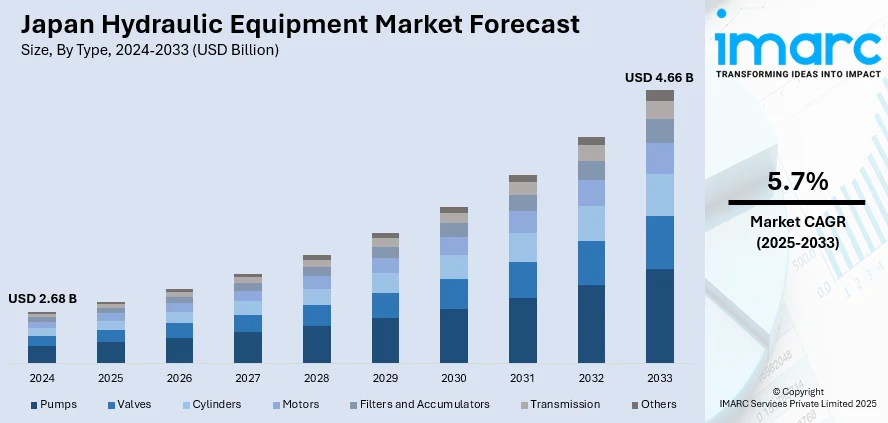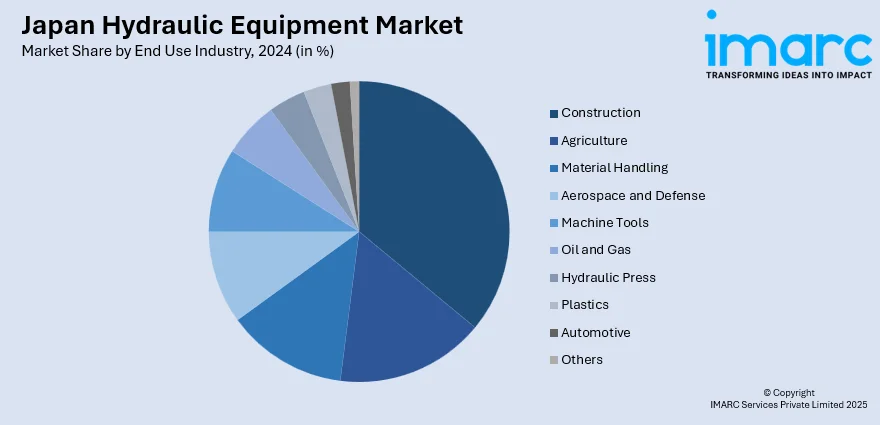
Japan Hydraulic Equipment Market Size, Share, Trends and Forecast by Type, End Use Industry, and Region, 2025-2033
Japan Hydraulic Equipment Market Overview:
The Japan hydraulic equipment market size reached USD 2.68 Billion in 2024. Looking forward, IMARC Group expects the market to reach USD 4.66 Billion by 2033, exhibiting a growth rate (CAGR) of 5.7% during 2025-2033. Increasing infrastructure development, particularly in urban areas and transportation networks, is one of the factors contributing to Japan hydraulic equipment market share. Growth in industrial automation, including robotics, and the ongoing need to upgrade aging infrastructure, also fuel demand.
|
Report Attribute
|
Key Statistics
|
|---|---|
|
Base Year
|
2024
|
|
Forecast Years
|
2025-2033
|
|
Historical Years
|
2019-2024
|
| Market Size in 2024 | USD 2.68 Billion |
| Market Forecast in 2033 | USD 4.66 Billion |
| Market Growth Rate 2025-2033 | 5.7% |
Japan Hydraulic Equipment Market Trends:
Evolving Hydraulic Equipment Landscape
Japan's hydraulic equipment sector is experiencing a significant shift toward advanced and environmentally conscious solutions. Recent industry showcases in Nagano highlighted a strong push for next-generation excavators, designed for superior power, operational efficiency, and reduced environmental impact. This development underscores a rising market appetite for machinery that aligns with sustainable practices, driven by ongoing infrastructure projects and a national commitment to innovation. The emphasis on powerful yet eco-friendly hydraulic systems indicates a clear trajectory for the industry, moving toward more responsible and high-performance heavy machinery to meet the evolving demands of construction and development. This transformation in the market reflects a broader industry movement toward integrating environmental responsibility with robust operational capabilities, positioning Japan at the forefront of adopting cutting-edge, sustainable heavy machinery. This forward-looking approach is set to redefine operational standards across various sectors requiring hydraulic equipment. These factors are intensifying the Japan hydraulic equipment market growth. For example, in May 2025, Volvo CE held its "Volvo Days Japan 2025" event in Nagano, showcasing its commitment to the Japanese hydraulic equipment market. The event featured new generation excavators like the EC230 and ECR145, emphasizing their power, efficiency, and sustainable performance. These launches reflect the growing demand for advanced, eco-friendly hydraulic machinery in Japan, driven by infrastructure development and a focus on innovation and sustainability.

To get more information of this market, Request Sample
Advancements Reshaping Hydraulic Equipment
The Japanese hydraulic equipment sector is experiencing a significant evolution, marked by the introduction of highly advanced machinery. A notable development saw the unveiling of a new-generation hydraulic excavator, featuring integrated Information and Communication Technology (ICT) and intelligent machine control. This innovation directly addresses pressing concerns within the construction industry, particularly the growing scarcity of skilled labor and the critical need for enhanced operational efficiency and safety across worksites. This push for technologically sophisticated equipment reflects a broader movement to streamline construction processes and mitigate human resource challenges. Furthermore, the global showcase of a similar, internationally specified model underscores a commitment to disseminating these advancements. This indicates a future where connected, intelligent hydraulic machinery plays a central role in driving productivity and safety in demanding construction environments. For instance, Komatsu had a significant launch for the Japanese hydraulic equipment market with its new-generation PC200i-12 hydraulic excavator, which debuted in Japan in December 2024. Equipped with advanced Information and Communication Technology (ICT) and intelligent machine control, this model addresses critical challenges in the construction industry, such as skilled labor shortages and the need for greater efficiency and safety. Komatsu expanded its global reach with the European-spec PC220LCi-12 showcased at bauma 2025 in April.
Japan Hydraulic Equipment Market Segmentation:
IMARC Group provides an analysis of the key trends in each segment of the market, along with forecasts at the country and regional levels for 2025-2033. Our report has categorized the market based on type and end use industry.
Type Insights:
- Pumps
- Valves
- Cylinders
- Motors
- Filters and Accumulators
- Transmission
- Others
The report has provided a detailed breakup and analysis of the market based on the type. This includes pumps, valves, cylinders, motors, filters and accumulators, transmission, and others.
End Use Industry Insights:

- Construction
- Agriculture
- Material Handling
- Aerospace and Defense
- Machine Tools
- Oil and Gas
- Hydraulic Press
- Plastics
- Automotive
- Others
A detailed breakup and analysis of the market based on the end use industry have also been provided in the report. This includes construction, agriculture, material handling, aerospace and defense, machine tools, oil and gas, hydraulic press, plastics, automotive, and others.
Regional Insights:
- Kanto Region
- Kansai/Kinki Region
- Central/Chubu Region
- Kyushu-Okinawa Region
- Tohoku Region
- Chugoku Region
- Hokkaido Region
- Shikoku Region
The report has also provided a comprehensive analysis of all the major regional markets, which include Kanto region, Kansai/Kinki region, Central/Chubu region, Kyushu-Okinawa region, Tohoku region, Chugoku region, Hokkaido region, and Shikoku region.
Competitive Landscape:
The market research report has also provided a comprehensive analysis of the competitive landscape. Competitive analysis such as market structure, key player positioning, top winning strategies, competitive dashboard, and company evaluation quadrant has been covered in the report. Also, detailed profiles of all major companies have been provided.
Japan Hydraulic Equipment Market News:
- In March 2025, Hitachi Construction Machinery Co., Ltd. advanced the circular economy in Japan's hydraulic equipment market by pioneering the use of restored hydraulic oil. The company developed a technology to recycle used hydraulic oil, which was then commercially implemented in remanufactured excavators. As of March 12, a ZX135US-5B (13-ton class) hydraulic excavator, featuring the recycled oil and a manufacturer's warranty, was made available. This initiative significantly reduced crude oil consumption (approximately 10,000 liters per 13-ton excavator) and promoted sustainable practices in heavy machinery.
Japan Hydraulic Equipment Market Report Coverage:
| Report Features | Details |
|---|---|
| Base Year of the Analysis | 2024 |
| Historical Period | 2019-2024 |
| Forecast Period | 2025-2033 |
| Units | Billion USD |
| Scope of the Report |
Exploration of Historical Trends and Market Outlook, Industry Catalysts and Challenges, Segment-Wise Historical and Future Market Assessment:
|
| Types Covered | Pumps, Valves, Cylinders, Motors, Filters and Accumulators, Transmission, Others |
| End Use Industries Covered | Construction, Agriculture, Material Handling, Aerospace and Defense, Machine Tools, Oil and Gas, Hydraulic Press, Plastics, Automotive, Others |
| Regions Covered | Kanto Region, Kansai/Kinki Region, Central/Chubu Region, Kyushu-Okinawa Region, Tohoku Region, Chugoku Region, Hokkaido Region, Shikoku Region |
| Customization Scope | 10% Free Customization |
| Post-Sale Analyst Support | 10-12 Weeks |
| Delivery Format | PDF and Excel through Email (We can also provide the editable version of the report in PPT/Word format on special request) |
Key Questions Answered in This Report:
- How has the Japan hydraulic equipment market performed so far and how will it perform in the coming years?
- What is the breakup of the Japan hydraulic equipment market on the basis of type?
- What is the breakup of the Japan hydraulic equipment market on the basis of end use industry?
- What is the breakup of the Japan hydraulic equipment market on the basis of region?
- What are the various stages in the value chain of the Japan hydraulic equipment market?
- What are the key driving factors and challenges in the Japan hydraulic equipment market?
- What is the structure of the Japan hydraulic equipment market and who are the key players?
- What is the degree of competition in the Japan hydraulic equipment market?
Key Benefits for Stakeholders:
- IMARC’s industry report offers a comprehensive quantitative analysis of various market segments, historical and current market trends, market forecasts, and dynamics of the Japan hydraulic equipment market from 2019-2033.
- The research report provides the latest information on the market drivers, challenges, and opportunities in the Japan hydraulic equipment market.
- Porter's five forces analysis assist stakeholders in assessing the impact of new entrants, competitive rivalry, supplier power, buyer power, and the threat of substitution. It helps stakeholders to analyze the level of competition within the Japan hydraulic equipment industry and its attractiveness.
- Competitive landscape allows stakeholders to understand their competitive environment and provides an insight into the current positions of key players in the market.
Need more help?
- Speak to our experienced analysts for insights on the current market scenarios.
- Include additional segments and countries to customize the report as per your requirement.
- Gain an unparalleled competitive advantage in your domain by understanding how to utilize the report and positively impacting your operations and revenue.
- For further assistance, please connect with our analysts.
 Request Customization
Request Customization
 Speak to an Analyst
Speak to an Analyst
 Request Brochure
Request Brochure
 Inquire Before Buying
Inquire Before Buying




.webp)




.webp)












